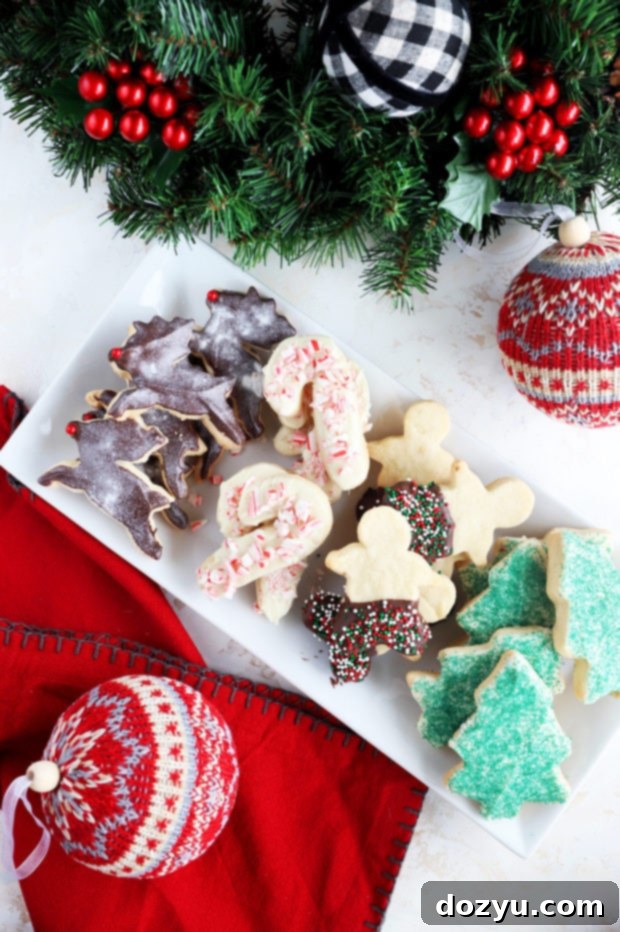The Easiest & Most Delicious Christmas Shortbread Cookies Recipe: A Holiday Tradition
Christmas Shortbread Cookies are the EASIEST cookie to make for the holidays. The dough comes together in minutes, thanks to the food processor, and with just 5 simple ingredients, they are perfect for your festive cookie platters! Plus, you can add endless variety with different decoration ideas. This recipe makes approximately 2 dozen delectable cookies.
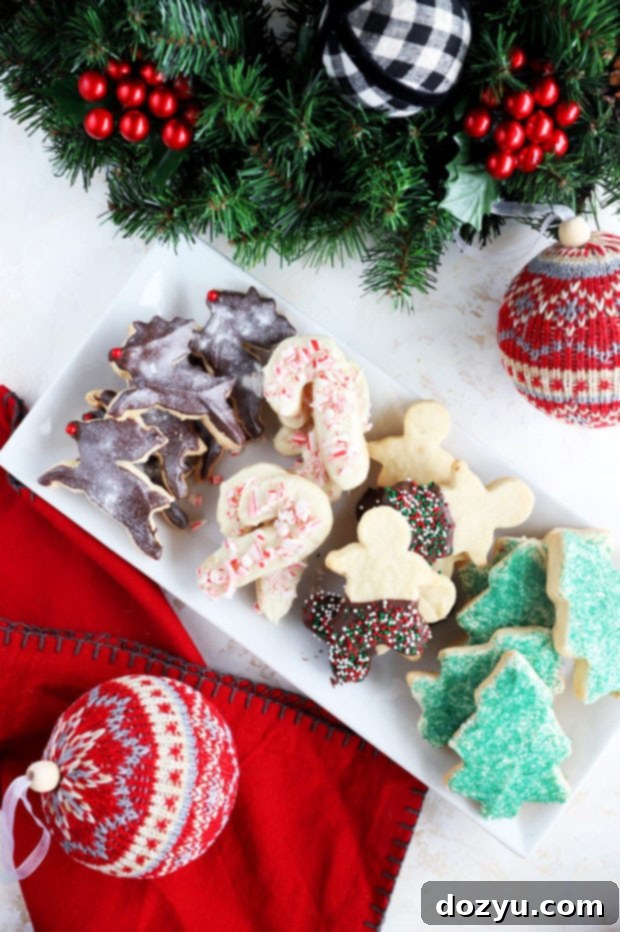
Table of Contents
About These Classic Christmas Shortbread Cookies
Christmas shortbread cookies are a timeless holiday classic for a reason. Their inherent simplicity and rich, buttery flavor make them an absolute must-have for any festive occasion. For many, they evoke feelings of warmth, family, and tradition. While sugar cookies often take center stage during the holidays for their elaborate decorating potential, I personally find myself reaching for shortbread when it comes to creating beautiful cut-out cookies that truly impress.
The allure of shortbread lies in its delightfully buttery profile and a sweetness that is perfectly balanced, never overwhelming. Unlike some sugar cookie recipes that can be overly sweet, shortbread offers a sophisticated taste that allows the pure flavor of butter to shine through. This makes them not only a joy to eat but also a fantastic canvas for various festive decorations without becoming cloyingly sweet. Imagine a perfectly crisp yet tender cookie that melts in your mouth – that’s the magic of shortbread.
For those preparing Christmas cookie boxes or looking to share homemade baked gifts, these easy Christmas cookies are an absolute godsend. Instead of laboring over multiple types of cookies – because, let’s be honest, holiday schedules are busy enough – I often opt for making one large batch of these incredible Christmas shortbread cookies. The dough is so forgiving and easy to work with, allowing you to focus your creative energy on decorating!
This approach opens up a world of possibilities for customization. You can easily vary the flavor and appearance by experimenting with different types of chocolate, glazes, or icing. From vibrant sprinkles and edible glitter to sophisticated crushed candy canes or toasted nuts, the decoration options are truly endless. Think beyond the basic and consider adding citrus zest to the dough, or infusing the melted chocolate with a hint of peppermint oil. With shortbread, every cookie becomes a miniature work of art, and each bite is a testament to the festive spirit.


This year, I’m especially thrilled to be participating in The Sweetest Season Cookie Exchange – an event I regrettably missed last year. Hosted by my wonderful friend Erin from The Speckled Palate, this week-long baking extravaganza isn’t just about sharing delicious recipes; it’s also about supporting a profoundly important cause: Cookies for Kids’ Cancer.
Supporting Cookies for Kids’ Cancer
Cookies for Kids’ Cancer is a commendable 501(c)3 non-profit organization dedicated to a critical mission: funding research for new, innovative, and less-toxic treatments for childhood cancer. Since its inception in 2008, this incredible organization has made a significant impact, granting nearly $17 million to pediatric cancer research. These funds have been distributed through over 100 research grants to leading pediatric cancer centers across the United States. The tangible results of this dedication are remarkable, with more than 35 new treatments now available to children battling cancer today.
Given that cancer remains the leading cause of death by disease among children in the U.S., our collective support is immensely vital. By contributing to Cookies for Kids’ Cancer, we help fund crucial research that leads to improved and gentler treatment options for these young fighters.
Currently, Cookies for Kids’ Cancer is running a special matching campaign with their generous partners at OXO. Every dollar raised through the end of 2021 will be matched, up to $100,000! This means any contribution we make will automatically double on our fundraising page. I invite you to join us in this meaningful effort by donating to this year’s fundraising page. Whether it’s a dollar or a hundred, every single contribution helps make a difference in a child’s life. Thank you for your kindness and support!
Looking for more delicious Christmas cookie recipes? Explore these favorites: Chewy Snickerdoodle Cookie Bars | Italian Rainbow Cookies | Gingerbread Cookies with Eggnog Cream Filling | White Chocolate Dipped Dark Chocolate Peppermint Cookies
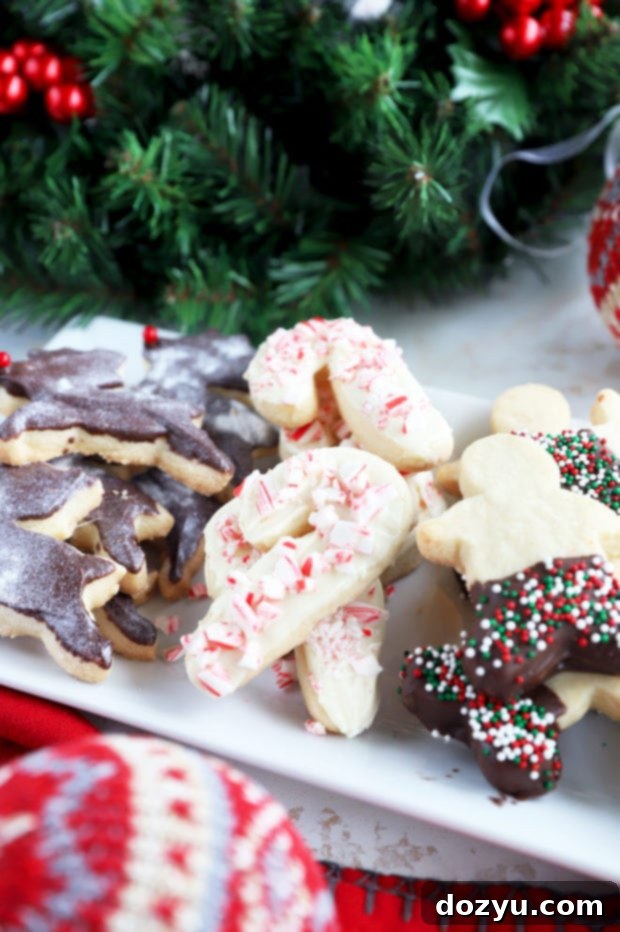
Key Ingredients for Perfect Shortbread: A Closer Look
The beauty of shortbread lies in its simplicity. With just a handful of high-quality ingredients, you can create cookies that are truly extraordinary. Understanding the role of each component is key to achieving that perfect texture and flavor.
- All-purpose flour: This forms the structural base of your cookies. For best results, use a good quality all-purpose flour. If you’re looking to make these cookies gluten-free, a 1-to-1 ratio gluten-free all-purpose flour blend can be successfully substituted, ensuring you still get that delightful shortbread crumb.
- Granulated sugar: Unlike royal icing or powdered sugar, granulated sugar provides the ideal level of sweetness and also contributes to the cookie’s tender crumb. It helps with the slight crispness on the exterior while keeping the interior soft.
- Chilled butter: This is arguably the most crucial ingredient in shortbread, as its flavor and texture are paramount. Using high-quality butter will elevate your cookies significantly. It’s essential that the butter is *chilled* and cut into small chunks. Cold butter prevents the dough from becoming too soft and ensures the fat is properly incorporated, leading to a tender, crumbly texture. You can use unsalted or salted butter based on your preference. I typically opt for unsalted butter to have full control over the salt content and allow the sweet, buttery notes to dominate, but a touch of saltiness can also be a delightful contrast.
- Heavy cream: A small amount of heavy cream brings the dough together and adds a touch of richness and moisture. It helps create a cohesive dough that is easy to roll out without becoming tough.
- Fine kosher salt: Salt is a flavor enhancer that balances the sweetness and brings out the deep, creamy notes of the butter. Fine kosher salt dissolves easily and distributes evenly throughout the dough.
- Decorations (optional, but highly recommended for holiday flair!): This is where you can let your creativity soar! Melted chocolate (dark, milk, or white) is a fantastic base for dipping. Once dipped, get creative with sprinkles, finely chopped nuts, crushed candy canes, or other festive candies. Royal icing also offers a beautiful, smooth finish if you prefer a more intricate design. And of course, leaving them plain is always an option – their buttery flavor stands perfectly on its own!

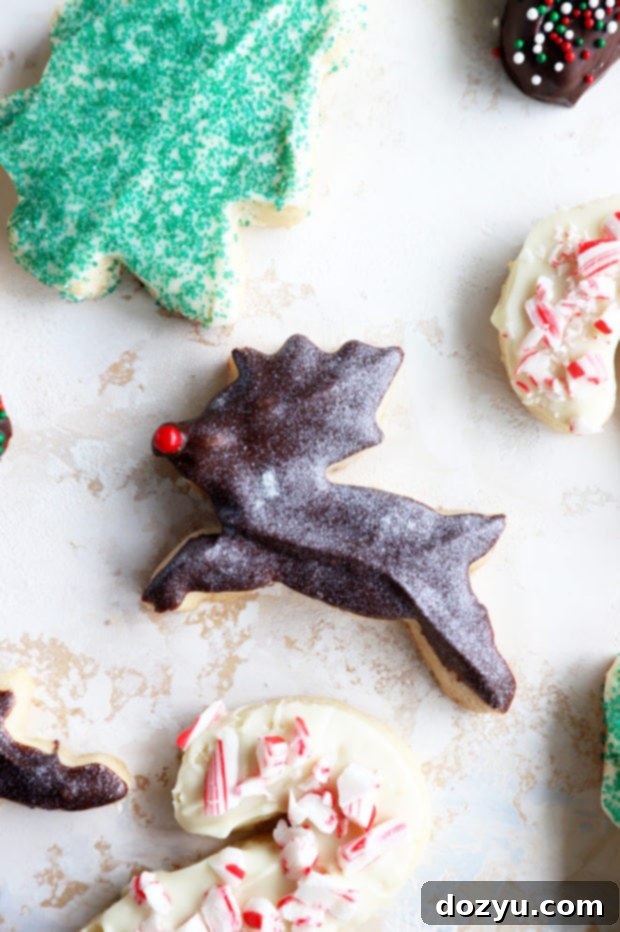
Essential Tools for This Recipe
One of the reasons this shortbread recipe is so easy is that it requires minimal specialized equipment. Here’s what you’ll need to get started:
- Food processor: This is your best friend for making shortbread dough quickly and efficiently. It ensures all ingredients are evenly combined and the butter is cut into the flour properly, without overworking the dough.
- Measuring cups and spoons: Accurate measurements are always crucial in baking for consistent results.
- Rolling pin: To achieve an even thickness for your cookies, a sturdy rolling pin is indispensable.
- Cookie cutters: Choose your favorite festive shapes – stars, trees, candy canes, snowflakes, or anything that sparks holiday joy!
- Half sheet baking pans: I recommend having two on hand so you can bake multiple batches efficiently.
- Silicone baking mats or parchment paper: These prevent sticking and ensure even browning. Silicone mats are reusable and provide excellent non-stick properties.
- Wire racks: Essential for cooling your cookies completely and preventing them from becoming soggy.
How to Make Christmas Shortbread Cookies!
Creating these delightful shortbread cookies is a straightforward process. Follow these steps for perfect results every time:
1. Prepare the Dough
The magic begins in your food processor. Add all five key ingredients: flour, sugar, chilled butter chunks, heavy cream, and salt to the bowl. Pulse the mixture a few times until it resembles fine, sandy crumbs. This initial pulsing helps to evenly distribute the butter throughout the flour. Then, continue to process on low speed. Watch closely as the mixture will gradually start to clump together, forming a shaggy dough. Stop processing as soon as it comes together to avoid overworking the gluten, which can lead to tough cookies.
2. Roll and Cut Your Festive Shapes
Once the dough has formed, transfer it from the food processor onto a lightly floured work surface. Gently knead the dough for just a couple of minutes until it becomes smooth and pliable. If your dough feels a bit dry or crumbly, especially in colder or drier climates, don’t hesitate to add an extra teaspoon of heavy cream, a little at a time, until it reaches the right consistency. It should be easy to handle without sticking excessively.
Using your rolling pin, roll the dough out evenly to about 1/2-inch thick. This thickness is crucial for that classic shortbread texture – sturdy enough to hold its shape but tender when bitten. Now comes the fun part: use your favorite holiday cookie cutters to create a variety of festive shapes. Gather any leftover dough scraps, gently re-roll them, and cut out more cookies until all the dough has been used. Remember to work quickly to keep the dough cool.
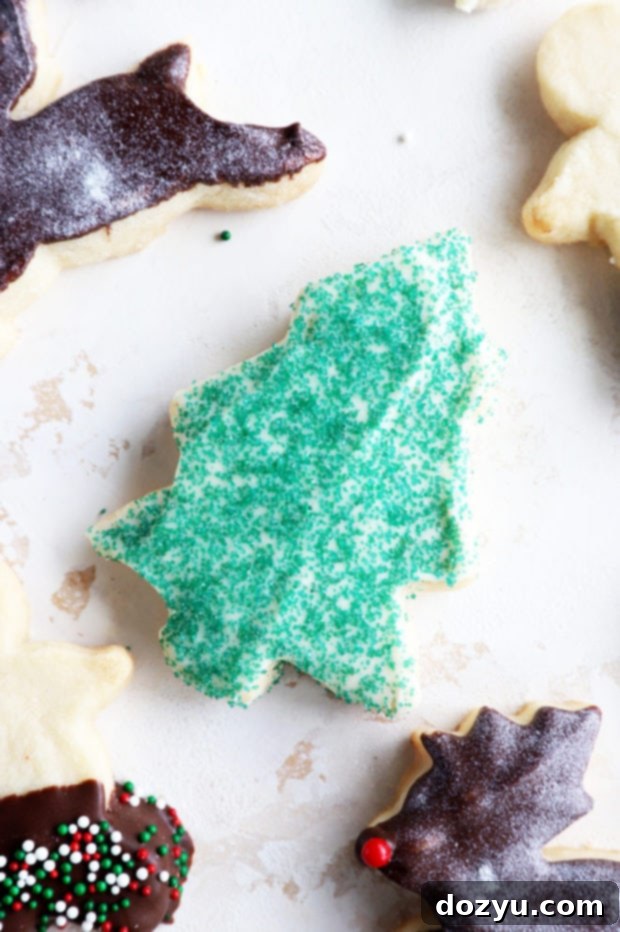
3. Bake to Golden Perfection
Carefully transfer your cut-out cookies onto lined baking sheets. I swear by silicone mats for their even heat distribution and easy release, but parchment paper works beautifully too. Preheat your oven to 325°F (160°C). Bake the cookies for approximately 20-25 minutes. The key here is to watch for the edges to *just* begin turning a delicate golden color. The centers will still feel quite soft to the touch, and this is perfectly normal. Overbaking shortbread can lead to a dry, overly crumbly texture, so err on the side of underbaking if you’re unsure. Once baked, remove the sheets from the oven and allow the cookies to cool completely on wire racks before you begin the decorating process. Cooling fully is essential to ensure your decorations adhere properly and don’t melt.
4. Decorate Your Holiday Masterpieces
Now for the most creative part! Once your shortbread cookies are completely cool, it’s time to decorate them to your heart’s content. You can dip them in melted dark, milk, or white chocolate for a luxurious coating. While the chocolate is still wet, sprinkle them with festive nonpareils, sparkling sugar, finely chopped pistachios, or a scattering of crushed candy canes. For a more classic and elegant look, consider piping designs with royal icing or a simple glaze. Alternatively, if you appreciate the pure, unadorned buttery flavor of shortbread, leaving them plain is always a wonderful option. Store your decorated (or un-decorated) cookies in an airtight container at room temperature to maintain their freshness for up to a week.
Need some more inspiration for sweet treats? Check out my dessert recipe page!
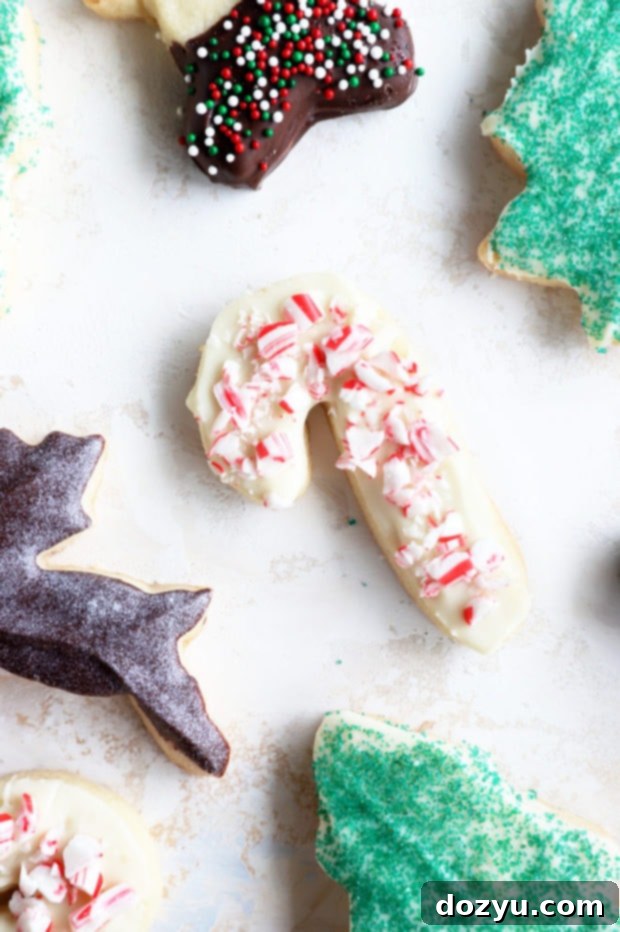
Is Shortbread Traditional at Christmas?
Absolutely, shortbread holds a deep and cherished tradition, particularly during the Christmas season! Its history dates back as far as the 12th century, originating in Scotland as a sweet biscuit bread. In its earliest forms, it was often made with yeast, but eventually evolved into the leavening-free, butter-rich cookie we know and love today. Historically, shortbread was considered a luxury and was primarily reserved for special celebrations. It graced tables during important events like christenings, weddings, and, significantly, family gatherings at Christmas and New Year’s Eve (Hogmanay in Scotland). Its rich, comforting flavor and tender texture made it a perfect indulgence for the festive period, a tradition that continues wholeheartedly to this day across the globe.
What is the Secret to Good Shortbread?
Achieving truly exceptional shortbread comes down to a few key principles. While the recipe is simple, mastering these elements will elevate your cookies from good to unforgettable:
- High-Quality Butter is Non-Negotiable: Since butter is the star of the show, its quality directly impacts the flavor. Invest in a good European-style butter if possible, as it often has a higher fat content, resulting in a richer, more pronounced buttery taste. Ensure your butter is chilled and cut into small pieces before adding it to the food processor. This helps create pockets of steam during baking, contributing to that signature tender, crumbly texture.
- Don’t Overwork the Dough: Shortbread gets its name because it’s “short” – meaning it has a high fat-to-flour ratio, inhibiting gluten development. Overworking the dough will develop too much gluten, making the cookies tough instead of tender and crumbly. Process it just until it comes together.
- Perfect Baking is Key: The biggest mistake people make with shortbread is overbaking it. Shortbread should be pale and barely colored around the edges, not deeply golden brown. It might even still feel a bit soft in the center when you remove it from the oven, but it will firm up as it cools. Overbaking leads to dry, hard, and overly crumbly cookies that lack that delightful melt-in-your-mouth quality.
- Chill, Chill, Chill: Chilling the dough before baking is crucial. It allows the butter to firm up, preventing the cookies from spreading too much in the oven and helping them maintain their crisp edges and distinct shapes.
- Correct Thickness: Rolling the dough to an even 1/2-inch thickness is important for consistent baking and texture. Thinner cookies will bake faster and be crispier; thicker ones will be more tender.
Can I Make the Dough Ahead of Time?
Absolutely! Christmas shortbread cookies are wonderfully suited for make-ahead preparation, which is a huge advantage during the busy holiday season. This flexibility allows you to spread out your baking tasks and enjoy a less stressful holiday. Here’s how you can prepare the dough in advance:
- Refrigerating the Dough: After preparing the dough, roll it out and cut your desired cookie shapes. Place the cut cookies on a baking sheet lined with parchment paper or silicone mats. Cover them loosely with plastic wrap and refrigerate for up to 3 days. When you’re ready to bake, you can transfer them directly from the fridge to the preheated oven. You might need to add a few extra minutes to the baking time since they are starting from a colder temperature.
- Freezing the Dough: For longer storage, shortbread dough freezes beautifully. Again, roll out the dough and cut your cookies into shapes. Arrange them on a baking sheet and freeze for about 1-2 hours, or until solid. This step prevents them from sticking together. Once frozen, transfer the solid cookie cut-outs into an airtight freezer-safe bag or container, separating layers with parchment paper. They can be stored in the freezer for up to 3 months. When it’s baking time, you can bake them directly from frozen. Just be sure to increase the baking time by several minutes (typically 5-10 minutes) to account for the frozen state.
- Freezing Baked Cookies: You can also bake the cookies completely, let them cool, and then freeze them. Once cooled, place them in a single layer on a baking sheet and freeze until solid. Then transfer them to an airtight freezer container, layering with parchment paper. Thaw at room temperature before serving or decorating. This is a great option if you want to get all your baking done well in advance.
Shortbread vs. Sugar Cookies: What’s the Difference?
While both shortbread and sugar cookies are beloved holiday cut-out cookies, they have distinct differences in their ingredients, texture, and flavor profile. Understanding these can help you choose the perfect cookie for your occasion.
- Fat Content: Shortbread typically has a higher butter-to-flour ratio than sugar cookies. This high fat content is what gives shortbread its signature “short” (meaning crumbly and tender) texture and rich, buttery flavor. Sugar cookies, while also containing butter, often have a more balanced ratio of fat, flour, and sugar.
- Leavening: A key difference is the absence of leavening agents (like baking powder or baking soda) in traditional shortbread. This results in a dense, crisp, and crumbly cookie that holds its shape beautifully. Sugar cookies, on the other hand, usually contain leavening agents, giving them a slightly softer, chewier texture and a bit more spread during baking.
- Sweetness: Shortbread is generally less sweet than sugar cookies. Its flavor profile leans heavily on the pure taste of butter, with just enough sugar to enhance it. Sugar cookies have a more pronounced sweet vanilla flavor that pairs well with frosting.
- Texture: Shortbread is known for its delicate, melt-in-your-mouth, crumbly texture. Sugar cookies tend to be chewier or firmer, depending on the recipe, and can range from soft to crisp.
- Flavor Profile: Shortbread offers a rich, unadulterated buttery flavor, often with a hint of vanilla or salt. Sugar cookies have a more pronounced sweet vanilla flavor that pairs well with frosting.
In essence, if you crave a cookie that celebrates the pure essence of butter with a tender crumb, shortbread is your go-to. If you prefer a sweeter, slightly chewier cookie that can handle bold frosting designs, sugar cookies are an excellent choice.
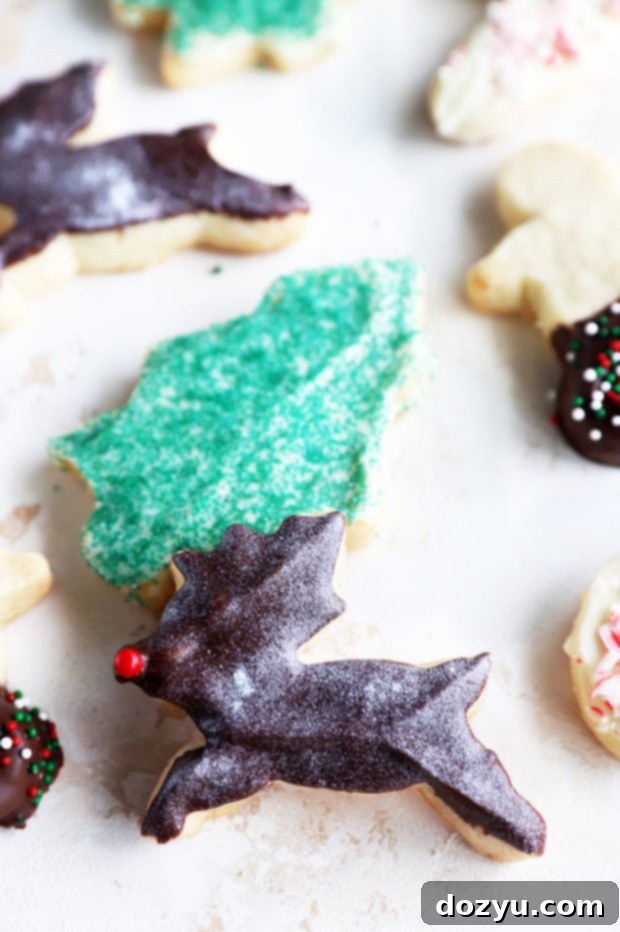
If you’re looking to round out your holiday cookie box, these chocolate dipped orange slices and cranberry pistachio biscotti are always fantastic additions. You can also stick with a beloved classic like these snowball cookies or these gorgeously decorated snowflake sugar cookies. Any of your favorite Christmas cookies will work beautifully to pair with this delightful shortbread!
For an elevated holiday gift, consider pairing a beautifully arranged plate of these cookies with a bottle of homemade Christmas gin. It’s a thoughtful and delicious gesture that’s sure to be appreciated.
Finally, if you make this Christmas shortbread cookies recipe, please be sure to give it a rating or leave a comment below! I genuinely love hearing about your baking experiences and take the time to respond to every single comment. Feel free to drop any questions you might have as well – I’m here to help! Oh, and don’t forget to tag me on Instagram if you share your creations! Seeing these recipes come to life in your homes is truly my favorite thing, and it means the world to me.
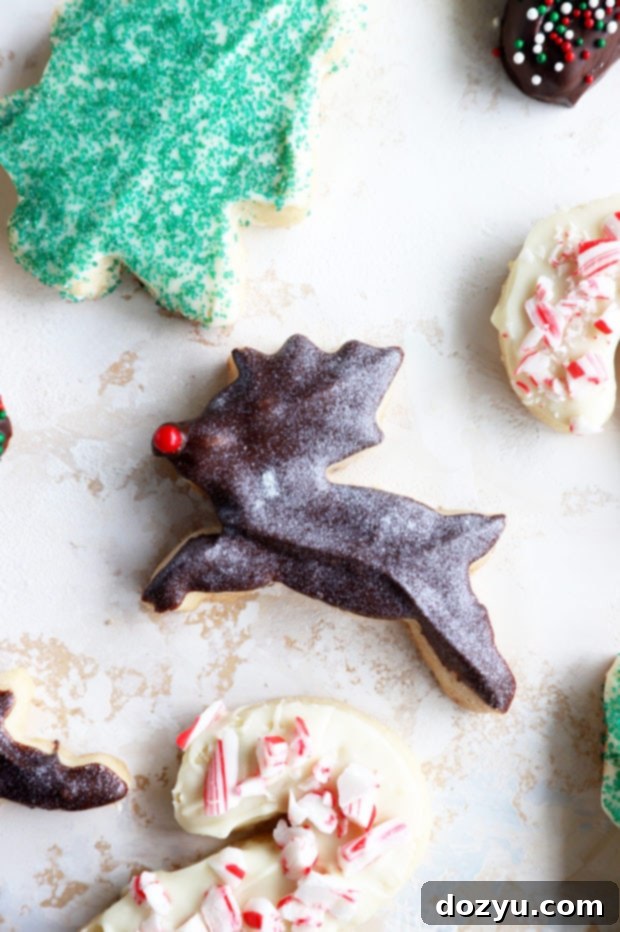
Christmas Shortbread Cookies
Equipment
- Food Processor (or a large bowl and pastry blender)
- Measuring Cups & Measuring Spoons
- Rolling Pin
- Half Sheet Baking Pans (2 are ideal)
- Silicone Baking Mats or Parchment Paper
- Cookie Cutter Set
- Wire Rack for cooling
Ingredients
- 2 1/2 cups all-purpose flour
- 2/3 cup granulated white sugar
- 1 cup chilled unsalted butter cut into 1-inch chunks
- 1 tsp heavy cream
- 1/4 teaspoon fine kosher salt
- Decorations optional: melted dark/milk/white chocolate, festive sprinkles, chopped nuts, crushed candy canes, royal icing, or edible glitter
Instructions
-
Prepare Your Baking Station: Preheat your oven to 325˚F (160°C). Line two large baking sheets with silicone mats or parchment paper, ensuring they are ready for your cookies.
-
Make the Dough: In the bowl of a food processor, combine the all-purpose flour, granulated sugar, chilled butter chunks, heavy cream, and salt. Pulse the ingredients until the mixture resembles fine crumbs. Then, continue to process on low speed until the mixture begins to clump together and form a cohesive dough. Be careful not to overmix.
-
Roll and Cut Cookies: Transfer the dough from the food processor onto a lightly floured work surface. Gently knead the dough for about 3 minutes until it becomes smooth and pliable. If the dough seems too dry or crumbly, incorporate an additional dash (about 1 tsp) of heavy cream as needed, especially in dry climates. Using a rolling pin, roll the dough out evenly to a thickness of 1/2 inch. Use your favorite holiday cookie cutters to cut out festive shapes. Carefully gather any remaining dough scraps, press them back together, and re-roll to cut out more cookies until all the dough is used.
-
Bake to Perfection: Arrange the cut-out cookies on the prepared baking sheets, leaving a little space between each. Bake for 20 to 25 minutes. The cookies are done when their edges are just beginning to turn a light golden brown; the centers will still be pale and may feel soft. Avoid overbaking to maintain their tender texture. Remove from the oven and transfer the cookies to wire racks to cool completely before decorating.
-
Decorate and Store: Once fully cooled, decorate your shortbread cookies as desired with melted chocolate, sprinkles, chopped nuts, or royal icing. Store the finished cookies in an airtight container at room temperature for up to one week. For longer storage, they can also be refrigerated or frozen (see “Can I Make the Dough Ahead of Time?” section for details).
